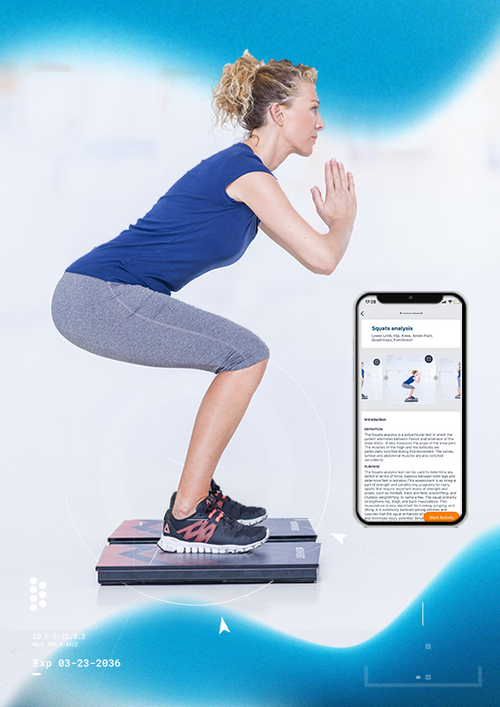Countermovement jump (CMJ) tests are a bread-and-butter exercise in the physical therapy and athletic conditioning worlds.
While the test is routine, the insights that can be gleaned from it are anything but.
Data gathered from CMJ tests can be used to calculate lower body power and explosive strength – two measurements that correlate with the subject’s sprint performance and 1RM maximal strength. Combined, those findings can be used to guide a therapist’s rehabilitation decisions and to assess an athlete’s readiness to return to sport.
Several techniques can be used to run a CMJ test. In the most rudimentary method, the subject marks their maximum height on the wall with chalk as they jump. And, while this technique can measure vertical height with relative accuracy, it cannot measure power, explosive strength, nor symmetry upon landing. For more comprehensive results, the test can be conducted with high-speed cameras, contact mats, accelerometers, and infrared platforms – a costly and complex endeavor.
While the methods above do produce valid results, the degree of accuracy and detail vary by technique. Luckily, one tool produces granular data about neuromuscular performance and consistent results every time: KINVENT’s K-Deltas Force Plates. The versatile, Bluetooth-enabled plates have high sampling and load rates and give users advanced biomechanical data via the KINVENT Physio App that can be leveraged to make well-informed rehabilitation and performance training decisions.
A new e-book from KINVENT outlines how the K-Deltas can be used in CMJ testing and explores the theory behind and applications of the test – below are some highlights from it.
Conducting the CMJ Test with the K-Deltas Force Plates
Set up for the CMJ test using the K-Deltas is straightforward. After warming up, the subject stands upright on the plates for at least three seconds, squats down, jumps as high as she can, as quickly as possible, then lands with control in the position she started. The test is then repeated several times.

The K-Deltas take careful measurements of the subject’s force and velocity at every phase of the test:
- Weighing Phase: calculates the subject’s weight as they stand still on the plates, preparing to jump
- Unweighting Phase: measures force from the instant body weight is reduced below a set threshold value of force through to force returning to subject’s body weight
- Braking Phase: measures the force and velocity of the subject’s extensor muscle-tendon unit as it stretches to decelerate body mass
- Propulsive Phase: measures the force and velocity of a subject as they extend their hips, knees and ankles to propel themself vertically
- Flight Phase: measures force from the instant of takeoff through to the subject’s return to the plates
- Landing Phase: measures the force exerted when the subject makes impact with the plates
As biomechanical data for each phase is collected, it is sent via Bluetooth to the KINVENT Physio App, where practitioners can watch the subject’s progress in real time.
K-Deltas CMJ Test Benefits
The K-Deltas generate highly accurate data for the following performance indicators:
- Jump height
- Peak force
- Peak power
- Rate of force development (maximum or average)
- Total impulse
- Concentric (upward) impulse
- Concentric (upward) duration
- Concentric (upward) peak force
- Concentric (upward) peak power
- Eccentric (downward) deceleration impulse
- Eccentric (downward) duration
- Eccentric (downward) peak braking force
- Eccentric (downward) peak
power - Bilateral and unilateral
asymmetry
Analog and other, more makeshift, methods of CMJ testing cannot provide the same exhaustive level of detail. The breadth and precision of data captured by the K-Deltas allows sports medicine practitioners, physical therapists, athletic trainers, and more to base their rehab and training plans off of all-inclusive evidence and highly reliable numbers – which, ultimately, helps patients and athletes achieve their goals more quickly.
Drive Better Patient Outcomes with KINVENT
The CMJ test is one of many that can be conducted on the K-Deltas force plates. Practitioners also use them to conduct push up tests, hand and shoulder tests, DSI assessments, and much more.
Beyond the plates, the KINVENT line of biomechanic equipment includes Bluetooth dynamometers and goniometers, that can be used to assess a range of force and movement analysis testing.
For a comprehensive overview of how the K-Deltas can be used to conduct the CMJ test – and guide patient care and training plans in the process – read the e-book.











